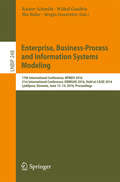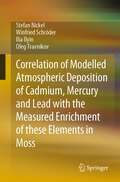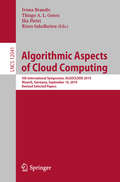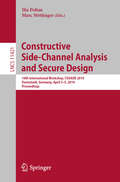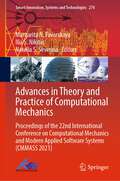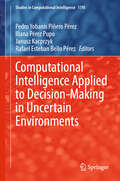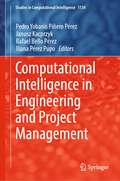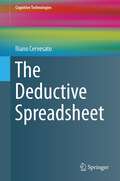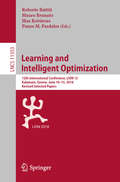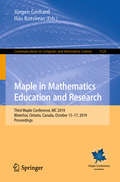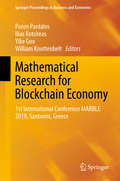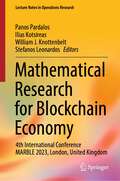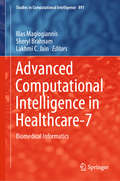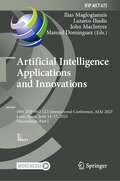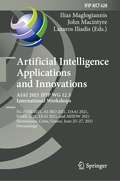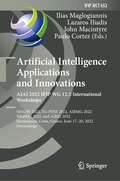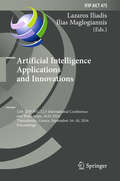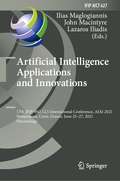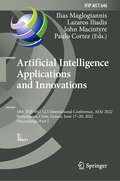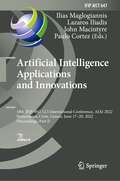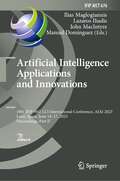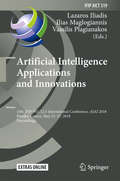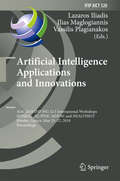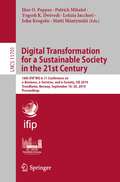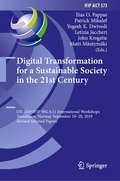- Table View
- List View
Enterprise, Business-Process and Information Systems Modeling
by Rainer Schmidt Wided Guédria Ilia Bider Sérgio GuerreiroThis book contains the refereed proceedings of the 17th International Conference on Business Process Modeling, Development and Support, BPMDS 2016, and the 21st International Conference on Exploring Modeling Methods for Systems Analysis and Design, EMMSAD 2016, held together with the 28th International Conference on Advanced Information Systems Engineering (CAiSE 2016) in Ljubljana, Slovenia, in June 2016. The focus theme for BPMDS 2016 papers was "Business Processes in a Connected World", for which three subthemes were identified: business processes for connecting people, connecting intelligent objects to business processes and connecting information/data/knowledge to business processes. The 17 full and 1 short paper accepted for BPMDS were selected from 48 submissions and are grouped into topical sections on process execution support; improving usability of process models; social and human perspectives; new directions in process modeling; consistency, correctness and compliance; process and data mining; and process variability. The intention of EMMSAD is to solicit papers related to the field of information systems analysis and design including numerous information modeling methods and notations that are typically evolving. These ongoing changes significantly impact the way information systems, enterprises, and business processes are being analyzed and designed in practice. The 12 full papers accepted for EMMSAD were chosen from 19 submissions and are grouped into topical sections on fundamental issues in modeling; requirements and regulations; enterprise and software ecosystem modeling; information and process model quality; meta-modeling and domain specific modeling and model composition; and modeling of architecture and design.
Correlation of Modelled Atmospheric Deposition of Cadmium, Mercury and Lead with the Measured Enrichment of these Elements in Moss
by Winfried Schröder Stefan Nickel Ilia Ilyin Oleg TravnikovThe book provides a unique analysis of current air pollution in Germany by correlating results from chemical transport modelling and accumulation monitoring by moss.Results of most recent modelling of atmospheric concentration and deposition of the metal elements Cd, Hg and Pb are compared with the results of technical measurements and bioindication with mosses. These modelling results with status 2020 have a higher spatial resolution of 0.1° x 0.1° than the modelling results valid up to then (50 km x 50 km). This leads to partly slightly higher correlations between the findings of the modelling and those of the moss monitoring. In this study, descriptive and correlation-statistical parameters are calculated, results and recommendations drawn described. A statistically adequately deepened analysis and evaluation of the highresolution modelling results requires additional methodological tools, which are outlined in summary. It is particularly important to link the exposure data from modelling, technical measurements and the findings from moss monitoring with information on the receptors, the ecosystem types. This is the only way to ensure that the results of the present project contribute to a more differentiated assessment of the impacts on ecosystems from atmospheric heavy metal deposition than has been the case to date, thus enabling a targeted further development of risk assessments for German
Algorithmic Aspects of Cloud Computing: 5th International Symposium, ALGOCLOUD 2019, Munich, Germany, September 10, 2019, Revised Selected Papers (Lecture Notes in Computer Science #12041)
by Rizos Sakellariou Ivona Brandic Thiago A. L. Genez Ilia PietriThis book constitutes the refereed post-conference proceedings of the 5th International Symposium on Algorithmic Aspects of Cloud Computing, ALGOCLOUD 2019, held in Munich, Germany, in September 2019. The 8 revised full papers were carefully reviewed and selected from 16 submissions. The aim of the symposium is to present research activities and results on topics related to algorithmic, design, and development aspects of modern cloud-based systems.
Constructive Side-Channel Analysis and Secure Design: 10th International Workshop, COSADE 2019, Darmstadt, Germany, April 3–5, 2019, Proceedings (Lecture Notes in Computer Science #11421)
by Ilia Polian Marc StöttingerThis book constitutes revised selected papers from the 10th International Workshop on Constructive Side-Channel Analysis and Secure Design, COSADE 2019, held in Darmstadt, Germany, in April 2019. The 14 papers presented together with one keynote and one invited talk in this volume were carefully reviewed and selected from 34 submissions. They were organized in topical sections named: Side-Channel Attacks; Fault-Injection Attacks; White-Box Attacks; Side-Channel Analysis Methodologies; Security Aspects of Post-Quantum Schemes; and Countermeasures Against Implementation Attacks.
Advances in Theory and Practice of Computational Mechanics: Proceedings of the 22nd International Conference on Computational Mechanics and Modern Applied Software Systems (CMMASS 2021) (Smart Innovation, Systems and Technologies #274)
by Margarita N. Favorskaya Ilia S. Nikitin Natalia S. SeverinaThis book is a collection of peer-reviewed best selected research papers presented at 22nd International Conference on Computational Mechanics and Modern Applied Software Systems (CMMASS 2021), held at the Alushta Health and Educational Center, The Republic of Crimea, during 4–13 September 2021. The proceedings is dedicated to solving the real-world problems of applied mechanics using smart computational technology. Physical and mathematical models, numerical methods, computational algorithms and software complexes are discussed, which allow to carry out high-precision mathematical modelling in fluid, gas and plasma mechanics, in general mechanics, deformable solid mechanics, in strength, destruction and safety of structures, etc. Smart technologies and software systems that provide effective solutions to the problems at various multi scale-levels are considered. Special attention is paid to the training of highly qualified specialists for the aviation and space industry.
Computational Intelligence Applied to Decision-Making in Uncertain Environments (Studies in Computational Intelligence #1195)
by Janusz Kacprzyk Pedro Yobanis Piñero Pérez Iliana Pérez Pupo Rafael Esteban Bello PérezThis book is dedicated to all those interested in the application of computational intelligence techniques for decision-making in uncertain environments. The book is organized into four parts. The first part groups together four works related to conversational systems and decision-making using generative artificial intelligence. The second part includes four articles associated with decision-making in project-oriented environments. The third part includes three works related to decision-making in human health environments and decision-making in sports training. The fourth part of the book contains three articles associated with business decision-making. This book combines different artificial intelligence techniques for solving decision-making problems, among which the following stand out: generative artificial intelligence, linguistic data summarization techniques, neutrosophic theory, computing with words, among other techniques. The techniques proposed in the book aim to simulate human tolerance in decision-making processes in environments with uncertainty and imprecision. The authors of the book stand out for their extensive experience in the development of basic and applied applications of computational intelligence. The authors Pedro Y. Piñero Pérez, Iliana Pérez Pupo, Janusz Kacprzyk, and Rafael E. Bello Pérez have published several books associated with artificial intelligence and applied computational intelligence. They continue to work on fundamental and applied research on different artificial intelligence techniques to assist decision-making in different areas of knowledge. The authors thank all the engineers, professors, and researchers without whose efforts this book could not have been written.
Computational Intelligence in Engineering and Project Management (Studies in Computational Intelligence #1134)
by Janusz Kacprzyk Rafael Bello Pérez Pedro Yobanis Piñero Pérez Iliana Pérez PupoThis book is dedicated to all those interested in the application of artificial intelligence in engineering and project management. Most of the jobs are focused on achieving agile project development. New algorithms that combine various computational intelligence techniques are applied in different areas of knowledge in project management.In this book, computational intelligence is presented as the branch of AI that encompasses various techniques aimed at simulating human tolerance in decision-making processes in environments with uncertainty and imprecision. Among the precursor techniques of computational intelligence are: evolutionary algorithms, artificial neural networks, fuzzy set theory, and fuzzy systems. However, other areas such as the rough set, linguistic data summary, natural language processing, the conversational systems, fuzzy cognitive maps, collective intelligence, the neutrosophic theory, and other fuzzy logic extensions are contributing to the application and extension of computational intelligenceThe book is organized into three parts, as shown below. The first part constitutes a critical review of computational intelligence in project management. The second part presents new computational intelligence techniques and their applications in project planning, control, and monitoring processes. In particular, the use of conversational systems and their applicability in the agile management of portfolio programs and projects stand out. Part three of the book exemplifies the use of computing techniques with words and other computational intelligence techniques for organizational decision-making.The authors of the book stand out for their extensive experience in the development of basic and applied applications of computational intelligence. The authors Janusz Kacprzyk, Pedro Y. Piñero Pérez, Rafael E. Bello Pérez, and Iliana Pérez Pupo have published several books associated with artificial intelligence and computational intelligence applied to projects. They continue working on fundamental-oriented and applied research on different artificial intelligence techniques to help with decision-making in different areas of knowledge.Authors would like to thank all the engineers, professors, and researchers without whose efforts this book could not have been written.
The Deductive Spreadsheet
by Iliano CervesatoThis book describes recent multidisciplinary research at the confluence of the fields of logic programming, database theory and human-computer interaction. The goal of this effort was to develop the basis of a deductive spreadsheet, a user productivity application that allows users without formal training in computer science to make decisions about generic data in the same simple way they currently use spreadsheets to make decisions about numerical data. The result is an elegant design supported by the most recent developments in the above disciplines. The first half of the book focuses on the deductive engine that underlies this application, the foundations that users do not see. After giving a mathematical model of traditional spreadsheet applications, we extend them with operators to perform a number of relational tasks, similar to the user view of a database but in a spreadsheet context. Expressing this extension in a logic programming framework is a natural step towards giving it powerful deductive capabilities. The second half of the book deals with the user interface, the part of the application with which the user actually interacts. We review the elements of the graphical user interface of traditional spreadsheet applications and describe practical methodologies for designing user interfaces borrowed from the field of cognitive psychology. We then propose a design that conservatively integrates mechanisms for a user to take advantage of the new deductive capabilities. This is followed by the results of some preliminary usability experiments. The book will appeal to researchers and practitioners in the various areas underlying this work. Researchers will not only find interesting new developments in their domains, but will also learn how to achieve a multidisciplinary focus. Practitioners will find fully developed solutions to numerous problems that are not easily solvable using traditional spreadsheet applications.
Learning and Intelligent Optimization: 12th International Conference, LION 12, Kalamata, Greece, June 10–15, 2018, Revised Selected Papers (Lecture Notes in Computer Science #11353)
by Panos M. Pardalos Roberto Battiti Mauro Brunato Ilias KotsireasThis book constitutes the thoroughly refereed post-conference proceedings of the 12th International Conference on Learning and Intelligent Optimization, LION 12, held in Kalamata, Greece, in June 2018. The 28 full papers and 12 short papers presented have been carefully reviewed and selected from 62 submissions. The papers explore the advanced research developments in such interconnected fields as mathematical programming, global optimization, machine learning, and artificial intelligence. Special focus is given to advanced ideas, technologies, methods, and applications in optimization and machine learning.
Maple in Mathematics Education and Research: Third Maple Conference, MC 2019, Waterloo, Ontario, Canada, October 15–17, 2019, Proceedings (Communications in Computer and Information Science #1125)
by Jürgen Gerhard Ilias KotsireasThis book constitutes the refereed proceedings of the third Maple Conference, MC 2019, held in Waterloo, Ontario, Canada, in October 2019. The 21 revised full papers and 9 short papers were carefully reviewed and selected out of 37 submissions, one invited paper is also presented in the volume. The papers included in this book cover topics in education, algorithms, and applciations of the mathematical software Maple.
Mathematical Research for Blockchain Economy: 1st International Conference MARBLE 2019, Santorini, Greece (Springer Proceedings in Business and Economics)
by Panos Pardalos Ilias Kotsireas William Knottenbelt Yike GuoThis book presents the best papers from the 1st International Conference on Mathematical Research for Blockchain Economy (MARBLE) 2019, held in Santorini, Greece. While most blockchain conferences and forums are dedicated to business applications, product development or Initial Coin Offering (ICO) launches, this conference focused on the mathematics behind blockchain to bridge the gap between practice and theory. Every year, thousands of blockchain projects are launched and circulated in the market, and there is a tremendous wealth of blockchain applications, from finance to healthcare, education, media, logistics and more. However, due to theoretical and technical barriers, most of these applications are impractical for use in a real-world business context. The papers in this book reveal the challenges and limitations, such as scalability, latency, privacy and security, and showcase solutions and developments to overcome them.
Mathematical Research for Blockchain Economy: 4th International Conference MARBLE 2023, London, United Kingdom (Lecture Notes in Operations Research)
by Panos Pardalos Ilias Kotsireas William J. Knottenbelt Stefanos LeonardosThis book presents the best papers from the 4th International Conference on Mathematical Research for Blockchain Economy (MARBLE) 2023, held in London, UK. While most blockchain conferences and forums are dedicated to business applications, product development, or Initial Coin Offering (ICO) launches, this conference focused on the mathematics behind blockchain to bridge the gap between practice and theory. The book spans the divide between theoretical promise and practical reality in blockchain technology and explores the challenges hindering its real-world integration across diverse sectors, offering comprehensive insights into issues like scalability, security, and privacy.
Advanced Computational Intelligence in Healthcare-7: Biomedical Informatics (Studies in Computational Intelligence #891)
by Lakhmi C. Jain Sheryl Brahnam Ilias MaglogiannisThis book presents state-of-the-art works and systematic reviews in the emerging field of computational intelligence (CI) in electronic health care. The respective chapters present surveys and practical examples of artificial intelligence applications in the areas of Human-Machine Interface (HMI) and affective computing, machine learning, big health data and visualization analytics, computer vision and medical image analysis. The book also addresses new and emerging topics in CI for health care such as the utilization of Social Media (SM) and the introduction of new intelligent paradigms in the security and privacy domains, which are critical for the health sector. The chapters, while of course not exhaustively addressing all the possible aspects of the aforementioned areas, are indicative of the dynamic nature of interdisciplinary research being pursued. Accordingly, the book is intended not only for researchers in the respective fields, but also for medical and administrative personnel working in the health sector, as well as managers and stakeholders responsible for making strategic decisions and defining public health policies.
Artificial Intelligence Applications and Innovations: 19th IFIP WG 12.5 International Conference, AIAI 2023, León, Spain, June 14–17, 2023, Proceedings, Part I (IFIP Advances in Information and Communication Technology #675)
by Lazaros Iliadis Ilias Maglogiannis John MacIntyre Manuel DominguezThis two-volume set of IFIP-AICT 675 and 676 constitutes the refereed proceedings of the 19th IFIP WG 12.5 International Conference on Artificial Intelligence Applications and Innovations, AIAI 2023, held in León, Spain, during June 14–17, 2023. This event was held in hybrid mode. The 75 regular papers and 17 short papers presented in this two-volume set were carefully reviewed and selected from 185 submissions. The papers cover the following topics: Deep Learning (Reinforcement/Recurrent Gradient Boosting/Adversarial); Agents/Case Based Reasoning/Sentiment Analysis; Biomedical - Image Analysis; CNN - Convolutional Neural Networks YOLO CNN; Cyber Security/Anomaly Detection; Explainable AI/Social Impact of AI; Graph Neural Networks/Constraint Programming; IoT/Fuzzy Modeling/Augmented Reality; LEARNING (Active-AutoEncoders-Federated); Machine Learning; Natural Language; Optimization-Genetic Programming; Robotics; Spiking NN; and Text Mining /Transfer Learning.
Artificial Intelligence Applications and Innovations. AIAI 2021 IFIP WG 12.5 International Workshops: 5G-PINE 2021, AI-BIO 2021, DAAI 2021, DARE 2021, EEAI 2021, and MHDW 2021, Hersonissos, Crete, Greece, June 25–27, 2021, Proceedings (IFIP Advances in Information and Communication Technology #628)
by Lazaros Iliadis Ilias Maglogiannis John MacintyreThis book constitutes the refereed proceedings of six International Workshops held as parallel events of the 17th IFIP WG 12.5 International Conference on Artificial Intelligence Applications and Innovations, AIAI 2021, virtually and in Hersonissos, Crete, Greece, in June 2021: the 6th Workshop on 5G-Putting Intelligence to the Network Edge, 5G-PINE 2021; Artificial Intelligence in Biomedical Engineering and Informatics Workshop, AI-BIO 2021; Workshop on Defense Applications of AI, DAAI 2021; Distributed AI for Resource-Constrained Platforms Workshop, DARE 2021; Energy Efficiency and Artificial Intelligence Workshop, EEAI 2021; and the 10th Mining Humanistic Data Workshop, MHDW 2021. The 24 full papers and 16 short papers presented at these workshops were carefully reviewed and selected from 72 submissions. The papers presented at 5G-PINE focus on the latest AI applications in the telecommunication industry and AI in modern 5G-oriented telecommunications infrastructures. The papers chosen for AI-BIO 2021 present research on the subject of AI, in its broadest sense, in biomedical engineering and health informatics. The DAAI 2021 papers aim at presenting recent evolutions in artificial intelligence applicable to defense and security applications. The papers selected for DARE 2021 address a variety of pertinent and challenging topics within the scope of distributed AI for resource-constrained platforms. The papers presented at EEAI 2021 aim to bring together interdisciplinary approaches that focus on the application of AI-driven solutions for increasing and improving energy efficiency of residential and tertiary buildings and of occupant behavior. The MHDW papers focus on topics such as recommendation systems, sentiment analysis, pattern recognition, data mining, and time series.
Artificial Intelligence Applications and Innovations. AIAI 2022 IFIP WG 12.5 International Workshops: MHDW 2022, 5G-PINE 2022, AIBMG 2022, ML@HC 2022, and AIBEI 2022, Hersonissos, Crete, Greece, June 17–20, 2022, Proceedings (IFIP Advances in Information and Communication Technology #652)
by Paulo Cortez Lazaros Iliadis Ilias Maglogiannis John MacintyreThis book constitutes the refereed proceedings of five International Workshops held as parallel events of the 18th IFIP WG 12.5 International Conference on Artificial Intelligence Applications and Innovations, AIAI 2022, virtually and in Hersonissos, Crete, Greece, in June 2022: the 11th Mining Humanistic Data Workshop (MHDW 2022); the 7th 5G-Putting Intelligence to the Network Edge Workshop (5G-PINE 2022); the 1st workshop on AI in Energy, Building and Micro-Grids (AIBMG 2022); the 1st Workshop/Special Session on Machine Learning and Big Data in Health Care (ML@HC 2022); and the 2nd Workshop on Artificial Intelligence in Biomedical Engineering and Informatics (AIBEI 2022). The 35 full papers presented at these workshops were carefully reviewed and selected from 74 submissions.
Artificial Intelligence Applications and Innovations: 12th IFIP WG 12.5 International Conference and Workshops, AIAI 2016, Thessaloniki, Greece, September 16-18, 2016, Proceedings (IFIP Advances in Information and Communication Technology #475)
by Lazaros Iliadis Ilias MaglogiannisArtificial Intelligence applications build on a rich and proven theoretical background to provide solutions to a wide range of real life problems. The ever expanding abundance of information and computing power enables researchers and users to tackle higly interesting issues for the first time, such as applications providing personalized access and interactivity to multimodal information based on preferences and semantic concepts or human-machine interface systems utilizing information on the affective state of the user. The purpose of the 3rd IFIP Conference on Artificial Intelligence Applications and Innovations (AIAI) is to bring together researchers, engineers, and practitioners interested in the technical advances and business and industrial applications of intelligent systems. AIAI 2006 is focused on providing insights on how AI can be implemented in real world applications.
Artificial Intelligence Applications and Innovations: 17th IFIP WG 12.5 International Conference, AIAI 2021, Hersonissos, Crete, Greece, June 25–27, 2021, Proceedings (IFIP Advances in Information and Communication Technology #627)
by Lazaros Iliadis Ilias Maglogiannis John MacintyreThis book constitutes the refereed proceedings of the 17th IFIP WG 12.5 International Conference on Artificial Intelligence Applications and Innovations, AIAI 2021, held virtually and in Hersonissos, Crete, Greece, in June 2021.The 50 full papers and 11 short papers presented were carefully reviewed and selected from 113 submissions. They cover a broad range of topics related to technical, legal, and ethical aspects of artificial intelligence systems and their applications and are organized in the following sections: adaptive modeling/ neuroscience; AI in biomedical applications; AI impacts/ big data; automated machine learning; autonomous agents; clustering; convolutional NN; data mining/ word counts; deep learning; fuzzy modeling; hyperdimensional computing; Internet of Things/ Internet of energy; machine learning; multi-agent systems; natural language; recommendation systems; sentiment analysis; and smart blockchain applications/ cybersecurity. Chapter “Improving the Flexibility of Production Scheduling in Flat Steel Production Through Standard and AI-based Approaches: Challenges and Perspective” is available open access under a Creative Commons Attribution 4.0 International License via link.springer.com.
Artificial Intelligence Applications and Innovations: 18th IFIP WG 12.5 International Conference, AIAI 2022, Hersonissos, Crete, Greece, June 17–20, 2022, Proceedings, Part I (IFIP Advances in Information and Communication Technology #646)
by Paulo Cortez Lazaros Iliadis Ilias Maglogiannis John MacintyreThis book constitutes the refereed proceedings of five International Workshops held as parallel events of the 18th IFIP WG 12.5 International Conference on Artificial Intelligence Applications and Innovations, AIAI 2022, virtually and in Hersonissos, Crete, Greece, in June 2022: the 11th Mining Humanistic Data Workshop (MHDW 2022); the 7th 5G-Putting Intelligence to the Network Edge Workshop (5G-PINE 2022); the 1st workshop on AI in Energy, Building and Micro-Grids (AIBMG 2022); the 1st Workshop/Special Session on Machine Learning and Big Data in Health Care (ML@HC 2022); and the 2nd Workshop on Artificial Intelligence in Biomedical Engineering and Informatics (AIBEI 2022). The 35 full papers presented at these workshops were carefully reviewed and selected from 74 submissions.
Artificial Intelligence Applications and Innovations: 18th IFIP WG 12.5 International Conference, AIAI 2022, Hersonissos, Crete, Greece, June 17–20, 2022, Proceedings, Part II (IFIP Advances in Information and Communication Technology #647)
by Paulo Cortez Lazaros Iliadis Ilias Maglogiannis John MacintyreThis book constitutes the refereed proceedings of five International Workshops held as parallel events of the 18th IFIP WG 12.5 International Conference on Artificial Intelligence Applications and Innovations, AIAI 2022, virtually and in Hersonissos, Crete, Greece, in June 2022: the 11th Mining Humanistic Data Workshop (MHDW 2022); the 7th 5G-Putting Intelligence to the Network Edge Workshop (5G-PINE 2022); the 1st workshop on AI in Energy, Building and Micro-Grids (AIBMG 2022); the 1st Workshop/Special Session on Machine Learning and Big Data in Health Care (ML@HC 2022); and the 2nd Workshop on Artificial Intelligence in Biomedical Engineering and Informatics (AIBEI 2022). The 35 full papers presented at these workshops were carefully reviewed and selected from 74 submissions.
Artificial Intelligence Applications and Innovations: 19th IFIP WG 12.5 International Conference, AIAI 2023, León, Spain, June 14–17, 2023, Proceedings, Part II (IFIP Advances in Information and Communication Technology #676)
by Lazaros Iliadis Ilias Maglogiannis John MacIntyre Manuel DominguezThis two-volume set of IFIP-AICT 675 and 676 constitutes the refereed proceedings of the 19th IFIP WG 12.5 International Conference on Artificial Intelligence Applications and Innovations, AIAI 2023, held in León, Spain, during June 14–17, 2023. This event was held in hybrid mode.The 75 regular papers and 17 short papers presented in this two-volume set were carefully reviewed and selected from 185 submissions. The papers cover the following topics: Deep Learning (Reinforcement/Recurrent Gradient Boosting/Adversarial); Agents/Case Based Reasoning/Sentiment Analysis; Biomedical - Image Analysis; CNN - Convolutional Neural Networks YOLO CNN; Cyber Security/Anomaly Detection; Explainable AI/Social Impact of AI; Graph Neural Networks/Constraint Programming; IoT/Fuzzy Modeling/Augmented Reality; LEARNING (Active-AutoEncoders-Federated); Machine Learning; Natural Language; Optimization-Genetic Programming; Robotics; Spiking NN; and Text Mining /Transfer Learning.
Artificial Intelligence Applications and Innovations: Aiai 2018 Ifip Wg 12. 5 International Workshops, Sedseal, 5g-pine, Mhdw, And Healthiot, Rhodes, Greece, May 25-27, 2018, Proceedings (IFIP Advances in Information and Communication Technology #520)
by Lazaros Iliadis Ilias Maglogiannis Vassilis PlagianakosThis book constitutes the refereed proceedings of the 14th IFIP WG 12.5 International Conference on Artificial Intelligence Applications and Innovations, AIAI 2018, held in Rhodes, Greece, in May 2018.The 42 full papers and 12 short papers were carefully reviewed and selected from 88 submissions. They are organized in the following topical sections: social media, games, ontologies; deep learning; support vector machines; constraints; machine learning, regression, classification; neural networks; medical intelligence; recommender systems; optimization; learning, intelligence; heuristic approaches, cloud; fuzzy; and human and computer interaction, sound, video, processing.
Artificial Intelligence Applications and Innovations: Aiai 2018 Ifip Wg 12. 5 International Workshops, Sedseal, 5g-pine, Mhdw, And Healthiot, Rhodes, Greece, May 25-27, 2018, Proceedings (IFIP Advances in Information and Communication Technology #520)
by Lazaros Iliadis Ilias Maglogiannis Vassilis PlagianakosThis book constitutes the refereed proceedings of 4 workshops held at the 14th IFIP WG 12.5 International Conference on Artificial Intelligence Applications and Innovations, AIAI 2018, held in Rhodes, Greece, in May 2018. The workshops were the Workshop on Semantics in the Deep: Semantic Analytics for Big Data, SEDSEAL 2018; the Third Workshop on 5G - Putting Intelligence to the Network Edge, 5G-PINE 2018; the 7th Mining Humanistic Data Workshop, MHDW 2018; and the Workshop on Intelligent Cloud and IOT Paradigms in EHealth, HEALTHIOT 2018.The 19 full papers and 5 short papers presented were carefully reviewed and selected from a total of 53 submissions: SEDSEAL accepted 2 full papers out of 5 submissions, 5G-PINE 6 full and one short paper out of 24, MHDW 7 full and 4 short papers out of 15, and HEALTHIOT 4 full papers out of 9. The papers cover topics such as AI in 5G and telecommunications, AI and e-health services, AI in 5G networks, incremental learning, clustering, AI in text mining, visual data analytics, AI in molecular biology, DNA, RNA, proteins, big data analytics, Internet of Things and recommender systems, and AI in biomedical applications.
Digital Transformation for a Sustainable Society in the 21st Century: 18th IFIP WG 6.11 Conference on e-Business, e-Services, and e-Society, I3E 2019, Trondheim, Norway, September 18–20, 2019, Proceedings (Lecture Notes in Computer Science #11701)
by Yogesh K. Dwivedi John Krogstie Matti Mäntymäki Letizia Jaccheri Ilias O. Pappas Patrick MikalefThis book constitutes the proceedings of the 18th IFIP WG 6.11 Conference on e-Business, e-Services, and e-Society, I3E 2019, held in Trondheim, Norway, in September 2019. The total of 61 full and 4 short papers presented in this volume were carefully reviewed and selected from 138 submissions. The papers were organized in topical sections named: e-business; big data analytics, open science and open data; artificial intelligence and internet of things; smart cities and smart homes, social media and analytics; digital governance; digital divide and social inclusion; learning and education; security in digital environments; modelling and managing the digital enterprise; digital innovation and business transformation; and online communities.
Digital Transformation for a Sustainable Society in the 21st Century: I3E 2019 IFIP WG 6.11 International Workshops, Trondheim, Norway, September 18–20, 2019, Revised Selected Papers (IFIP Advances in Information and Communication Technology #573)
by Yogesh K. Dwivedi John Krogstie Matti Mäntymäki Letizia Jaccheri Ilias O. Pappas Patrick MikalefThis book constitutes papers from the workshops held at the 18th IFIP WG 6.11 Conference on e-Business, e-Services, and e-Society, I3E 2019, which took place in Trondheim, Norway, in September 2019. The 11 full papers and 4 short papers presented in this volume were carefully reviewed and selected from 33 submissions to the following workshops:DTIS: Digital Transformation for an Inclusive SocietyTPSIE: Trust and Privacy Aspects of Smart Information Environments3(IT): Innovative Teaching of Introductory Topics in Information TechnologyCROPS: CROwd-Powered e-Services
